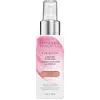What's inside
What's inside
 Key Ingredients
Key Ingredients

 Benefits
Benefits

 Concerns
Concerns

 Ingredients Side-by-side
Ingredients Side-by-side

Water
Skin ConditioningButylene Glycol
HumectantPvp
Emulsion StabilisingHydrolyzed Manihot Esculenta Tuber Extract
Skin ConditioningLycium Barbarum Fruit Extract
AstringentRosa Damascena Flower Water
MaskingTerminalia Ferdinandiana Fruit Extract
AntioxidantPPG-3 Benzyl Ether Myristate
EmollientPoloxamer 338
EmulsifyingPolysorbate 20
EmulsifyingPEG-10 Dimethicone
Skin ConditioningPhenoxyethanol
PreservativeCaprylyl Glycol
EmollientEthylhexylglycerin
Skin ConditioningHexylene Glycol
EmulsifyingParfum
MaskingTin Oxide
AbrasiveSodium Hydroxide
BufferingLeuconostoc/Radish Root Ferment Filtrate
AntimicrobialPotassium Sorbate
PreservativeSodium Benzoate
MaskingCitric Acid
BufferingCI 75470
Cosmetic ColorantCI 77491
Cosmetic ColorantMica
Cosmetic ColorantCI 77891
Cosmetic ColorantWater, Butylene Glycol, Pvp, Hydrolyzed Manihot Esculenta Tuber Extract, Lycium Barbarum Fruit Extract, Rosa Damascena Flower Water, Terminalia Ferdinandiana Fruit Extract, PPG-3 Benzyl Ether Myristate, Poloxamer 338, Polysorbate 20, PEG-10 Dimethicone, Phenoxyethanol, Caprylyl Glycol, Ethylhexylglycerin, Hexylene Glycol, Parfum, Tin Oxide, Sodium Hydroxide, Leuconostoc/Radish Root Ferment Filtrate, Potassium Sorbate, Sodium Benzoate, Citric Acid, CI 75470, CI 77491, Mica, CI 77891
Water
Skin ConditioningBis-PEG-18 Methyl Ether Dimethyl Silane
EmollientNiacinamide
SmoothingPhenoxyethanol
PreservativeZinc Gluconate
Skin ConditioningSodium PCA
HumectantDiglycerin
HumectantUrea
BufferingEthylhexylglycerin
Skin ConditioningDisodium EDTA
Glycerin
HumectantHydrolyzed Rice Protein
Skin ConditioningSorbitol
HumectantLysine
Skin ConditioningPCA
HumectantAllantoin
Skin ConditioningLactic Acid
BufferingSodium Hyaluronate
HumectantCroton Lechleri Resin Extract
Skin ConditioningGlutamylamidoethyl Imidazole
Parfum
MaskingGeraniol
PerfumingLimonene
PerfumingLinalool
PerfumingWater, Bis-PEG-18 Methyl Ether Dimethyl Silane, Niacinamide, Phenoxyethanol, Zinc Gluconate, Sodium PCA, Diglycerin, Urea, Ethylhexylglycerin, Disodium EDTA, Glycerin, Hydrolyzed Rice Protein, Sorbitol, Lysine, PCA, Allantoin, Lactic Acid, Sodium Hyaluronate, Croton Lechleri Resin Extract, Glutamylamidoethyl Imidazole, Parfum, Geraniol, Limonene, Linalool
 Reviews
Reviews

Ingredients Explained
These ingredients are found in both products.
Ingredients higher up in an ingredient list are typically present in a larger amount.
Ethylhexylglycerin (we can't pronounce this either) is commonly used as a preservative and skin softener. It is derived from glyceryl.
You might see Ethylhexylglycerin often paired with other preservatives such as phenoxyethanol. Ethylhexylglycerin has been found to increase the effectiveness of these other preservatives.
Parfum is a catch-all term for an ingredient or more that is used to give a scent to products.
Also called "fragrance", this ingredient can be a blend of hundreds of chemicals or plant oils. This means every product with "fragrance" or "parfum" in the ingredients list is a different mixture.
For instance, Habanolide is a proprietary trade name for a specific aroma chemical. When used as a fragrance ingredient in cosmetics, most aroma chemicals fall under the broad labeling category of “FRAGRANCE” or “PARFUM” according to EU and US regulations.
The term 'parfum' or 'fragrance' is not regulated in many countries. In many cases, it is up to the brand to define this term.
For instance, many brands choose to label themselves as "fragrance-free" because they are not using synthetic fragrances. However, their products may still contain ingredients such as essential oils that are considered a fragrance by INCI standards.
One example is Calendula flower extract. Calendula is an essential oil that still imparts a scent or 'fragrance'.
Depending on the blend, the ingredients in the mixture can cause allergies and sensitivities on the skin. Some ingredients that are known EU allergens include linalool and citronellol.
Parfum can also be used to mask or cover an unpleasant scent.
The bottom line is: not all fragrances/parfum/ingredients are created equally. If you are worried about fragrances, we recommend taking a closer look at an ingredient. And of course, we always recommend speaking with a professional.
Learn more about ParfumPhenoxyethanol is a preservative that has germicide, antimicrobial, and aromatic properties. Studies show that phenoxyethanol can prevent microbial growth. By itself, it has a scent that is similar to that of a rose.
It's often used in formulations along with Caprylyl Glycol to preserve the shelf life of products.
Water. It's the most common cosmetic ingredient of all. You'll usually see it at the top of ingredient lists, meaning that it makes up the largest part of the product.
So why is it so popular? Water most often acts as a solvent - this means that it helps dissolve other ingredients into the formulation.
You'll also recognize water as that liquid we all need to stay alive. If you see this, drink a glass of water. Stay hydrated!
Learn more about Water